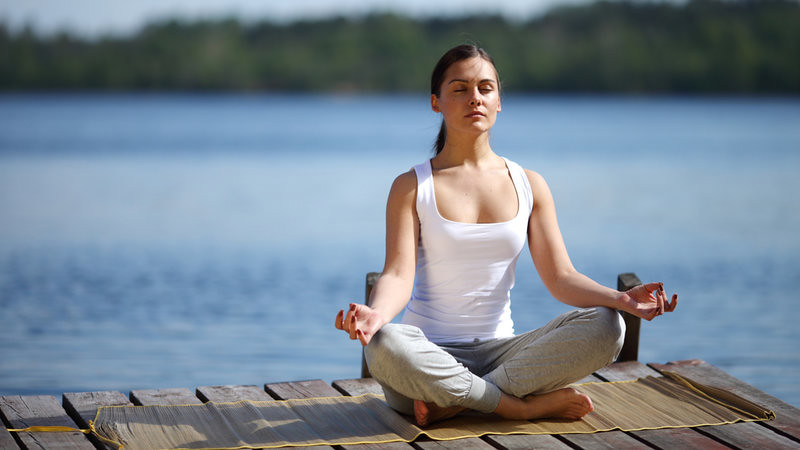Siddhasana: A Complete Guide with Steps, Benefits, and Precautions
Siddhasana is a yoga pose that is also known as “The Accomplished Pose”. Here in this post, we will learn Siddhasana’s steps, about the steps to perform.
 The word yoga has become most popular throughout the world, it is due to its tremendous health benefits. Yoga can also be defined as a way to Salvation (Moksha) and freedom from all sorts of pain thereby living a balanced life.
The word yoga has become most popular throughout the world, it is due to its tremendous health benefits. Yoga can also be defined as a way to Salvation (Moksha) and freedom from all sorts of pain thereby living a balanced life.
Yoga also means a way to connect the Soul with God. It is a way to make the disappearance of the mundane and trivial desires that arise in the mind. Yoga is the process of exercise through which man can control his overall physical and mental being.
It is a way to reach states of happiness which is until now unreached and able to conjecture in God or the Supreme Soul (Paramatma). Yoga offers a path to ultimate salvation, as well as a more temporary, temporary type in terms of alleviating unhappiness, the kind that certainly results from poor health.
The process or the practices of Yoga are very beneficial for the maintenance of overall health. It can help to maintain physical and mental health, which cannot be done by any medication itself.
Yoga helps to overcome mental depression as well as to achieve a balance between body and soul. Among many yoga poses Siddhasana is also one asana through which you can attain equilibrium in your body.
What is Siddhasana?
Siddhasana is also known as accomplished pose, The word Siddhasana comes from two Sanskrit words (Siddha+Asana) and is pronounced as (sid-HAHS-uh-nuh), The word ‘Siddha’ means to achieve, to accomplish, or to finish and the other word “Asana” means to sit in, a pose or a posture.
Siddhasana is one of the simple meditative postures among many yoga poses that can be performed for meditation or other yogic activities. According to the yoga text (Hath Yoga Pradipika) written in the 14th century CE, Siddhasana is the fourth yoga pose that is very effective for the possession of mediation (Dhyan).
There are more than 84 different and different variations of Asanas mentioned in Hatha Yoga Pradipika. This text also mentions that every yoga learner or student of yoga should try Siddhasana meditation as it is simple and very effective and people can get the best benefits from it.
According to the Hatha yoga Pradipika text, it describes that while practicing the Siddhasana pose all 72,000 nadis or channels are purified and energy or gateway of energy is produced into the body, through which prana flows. Some yoga practitioners do believe that performing Siddhasana has benefited them.
Siddhasana Steps, How To Do?
Steps:
- Sit straight on the floor, with both legs extended just in front of you. Keep your feet parallel to the floor, with balls of heels firmly planted on the floor.
- Now bend the left leg from the knee, bringing the left heel towards the perineum. Once your heel begins to touch the perineum, bend the right leg of the knee and let the right heel rest against the area of the pubic bone. Now let the right foot stay at an angle down.
Note: For the yogi beginner this step can be a little difficult and may feel pain, in that case, you can wedge a folded piece of cloth and insert it at the point where both ankles meet the ground.
- Now place one ankle on top of the other so there is no pressure on the genitals. The downward angle of the right foot should be able to help you with that. Allow both knees to touch the floor with the left heel.
- Now extend the spine and sit upright, beginners can fold a blanket and place it under their buttocks to help stretch and straighten the spine.
- Now stretch your arms forward and place both hands on each of your knees. Then place the tip of your thumb on the index finger on each of the hands, leaving another finger straight
- Now close your eyes and try to concentrate on meditating. Now stop thinking about the world, clear your head, and try focusing your attention on a point in space. Maintain normal breathing and stay in the posture for a few seconds, or possibly minutes till the time you feel comfortable.
- Now repeat the pose again by making alternative knees, reversing the order of your legs. Remain in the posture almost at the same time taken for the previous cycle.
Note: The breathing should be normal and continued during the reversing process.
Beginners Tip For Siddhasana Steps
Some new yogis may feel uncomfortable during this asana, so it is important that the person feels comfortable in the initial stage of Siddhasana.
They can make some modifications they require to feel firm, and confident and can get some support to perform the pose. Below are some suggestions which you can use to accomplish Siddhasana.
1. Use Cushions: If your hips are tight, avoid sitting directly on the floor. Instead, sit on a folded blanket or even two or three if needed to ensure comfort.
2. Raise Your Hips: Elevating your hips above knee level can reduce stress and discomfort in the hips, knees, and back. This also allows your groin to open up more, aligning your spine correctly.
3. Utilize Wall Support: To maintain an upright posture, lean against a wall for support. Alternatively, place a yoga block between your shoulder blades and the wall for added stability.
4. Practice Sukhasana: If Siddhasana feels challenging, practice the easier Sukhasana pose to build flexibility and strength in your body. Gradually transition to Siddhasana when you feel more comfortable and flexible.”
Siddhasana Benefits:
1. Enhanced Blood Flow:
Siddhasana’s unique posture involves placing the heels near the genitals. This placement encourages and enhances blood circulation in the pelvic region.
Improved blood flow in this area can have several positive effects, including better continence, or control over urinary and bowel functions.
By promoting healthy blood circulation, Siddhasana can contribute to improved pelvic health and overall bodily function.
2. Improved Sexual Health:
Siddhasana has been associated with potential benefits for sexual health. Regular practice of this asana may help alleviate certain sexual disorders.
Additionally, the improved blood circulation resulting from Siddhasana can positively impact sexual function.
Furthermore, Siddhasana’s influence on heart function and blood pressure regulation can indirectly contribute to overall sexual well-being.
3. Relief from Health Issues:
Siddhasana can offer relief to individuals dealing with specific health conditions. For instance, it can be particularly beneficial for those suffering from issues like piles and hemorrhoids.
The posture helps alleviate discomfort in the anal and rectal area, providing relief to those with these conditions.
4. Hormonal Regulation:
Siddhasana plays a role in hormonal regulation, particularly in men. It assists in controlling the flow of hormones from the testicles. This hormonal balance can have a notable impact on emotional regulation and sexual metabolism.
Additionally, Siddhasana is known to aid in preventing nighttime emissions, a condition that can be bothersome for some men.
5. Abdominal Circulation:
One of Siddhasana’s noteworthy effects is the redirection of blood circulation to the abdominal area. This increased blood flow to the abdomen can have several advantages.
It may improve digestion and nutrient absorption, leading to a healthier digestive system. Additionally, enhanced abdominal circulation can promote overall well-being by supporting the vital functions of the organs located in this region, such as the liver and intestines.
General Precautions:
- People having certain ailments or physical problems must avoid doing it. For example, the pose is not recommended for those who have recently had any surgery, especially on the back or hip.
- People who are suffering from lower back pain and sciatica must not perform this asana.
- People with recent knee injuries other knee pain, or arthritis should not do this asana.
Siddhasana is an asana that can bring you to the state of consciousness that goes beyond the rest states of awakening, dreaming, and experiencing a dreamless dream.
It is a rare and difficult state to achieve, but with the help of Siddhasana so-called Samadhi, you can naturally get to the next step.
Hatha Yoga Pradipika also states that this type of perfection may take a year to achieve depending on a person’s ability.
Commonly Asked Questions About Siddhasana
Q1: What is Siddhasana?
A1: Siddhasana is a meditative yoga pose that helps in concentration and inner balance. It involves specific leg and hand placements.
Q2: How do I perform Siddhasana?
A2: To do Siddhasana, sit with legs crossed, heels near the perineum, spine straight. Place hands on knees, palms up. Breathe deeply and meditate.
Q3: What are the benefits of Siddhasana?
A3: Siddhasana improves posture, aids digestion, enhances focus, and promotes mental calmness. It’s also used for energy circulation in yoga.
Q4: Are there any precautions to consider?
A4: If you have knee or hip issues, consult a yoga instructor. Maintain comfort; avoid straining. Ensure gradual progression in this pose.
Q5: Can beginners practice Siddhasana?
A5: Yes, beginners can practice Siddhasana with guidance. Start with shorter durations and gradually extend your practice as flexibility and comfort increase.
Q6: Is Siddhasana suitable for meditation?
A6: Absolutely, Siddhasana is excellent for meditation. Its comfortable seated position and alignment promote focused mindfulness.
Q7: How does Siddhasana benefit the body and mind?
A7: Siddhasana stimulates energy flow, enhances mental clarity, reduces stress, and brings a sense of balance to both body and mind.
Q8: Can Siddhasana help with spiritual growth?
A8: Yes, Siddhasana is considered a spiritual posture in yoga. Regular practice can aid in spiritual development and self-realization.
Q9: Are there variations of Siddhasana?
A9: Yes, there are variations like Ardha Siddhasana (Half Siddhasana) and Padmasana (Lotus Pose), which are more advanced forms of seated yoga postures.
Q10: Where can I learn more about Siddhasana?
A10: You can find detailed instructions, videos, and classes on Siddhasana from certified yoga instructors and reputable yoga websites.
In summary, Siddhasana offers a range of benefits that extend beyond its physical appearance. Its influence on blood circulation, hormonal regulation, and abdominal health can positively impact various aspects of well-being, making it a valuable addition to one’s yoga practice.


























